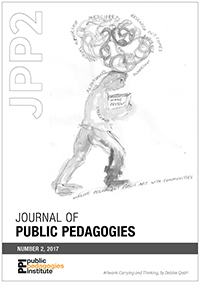Where the Wild Things are: Learning from Tunnerminnerwait and Maulboyheener
Abstract
Places are pedagogical; and they teach through a range of ways. In recent public pedagogy discourse Biesta (2014) puts forth three forms of public pedagogy. These three forms of publicness are; pedagogy for the public; pedagogy of the public; and pedagogy in the interests of publicness. What Biesta offers with these views of pedagogy in the public sphere, is an understand of the ways we teach and learn in public places, and how that pedagogy is performed. In particular a pedagogy in the interest of publicness sees grassroots community led pedagogy that acts in the interest of publicness. This provides a lens to examine how pedagogy and knowledge is held in public spaces. alter
Published
2017-11-21
How to Cite
Cooper J. (2017). Where the Wild Things are: Learning from Tunnerminnerwait and Maulboyheener. Journal of Public Pedagogies, (2). https://doi.org/10.15209/jpp.1129
Issue
Section
Reviews
This work is licensed under a Creative Commons Attribution-NonCommercial License. In short, copyright for articles published in this journal is retained by the authors, with first publication rights granted to the journal. By virtue of their appearance in this open access journal, articles are free to use, with proper attribution, in educational and other non-commercial settings. This is an Open Access Journal, and provides free, online, open access to its content on the principle that making research freely available to the public supports a greater global exchange of knowledge.



